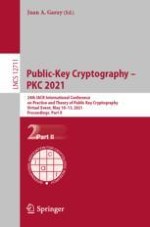2021 | OriginalPaper | Buchkapitel
Group Encryption: Full Dynamicity, Message Filtering and Code-Based Instantiation
verfasst von : Khoa Nguyen, Reihaneh Safavi-Naini, Willy Susilo, Huaxiong Wang, Yanhong Xu, Neng Zeng
Erschienen in: Public-Key Cryptography – PKC 2021
Aktivieren Sie unsere intelligente Suche, um passende Fachinhalte oder Patente zu finden.
Wählen Sie Textabschnitte aus um mit Künstlicher Intelligenz passenden Patente zu finden. powered by
Markieren Sie Textabschnitte, um KI-gestützt weitere passende Inhalte zu finden. powered by
